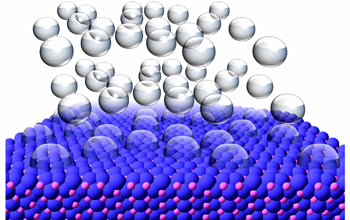Multimedia Gallery
Nanoparticle opens door to clean-energy alternatives
Cheaper, clean-energy technologies could be made possible due to the discovery that an important chemical reaction that generates hydrogen from water is effectively triggered--or catalyzed--by a nanoparticle composed of nickel and phosphorus, two inexpensive elements that are abundant on Earth. This image illustrates hydrogen gas bubbling off the surface of a nickel phosphide crystal.
The discovery was made by a team of researchers led by Raymond Schaak, a professor of chemistry at Penn State University. "Nanoparticle technology has already started to open the door to cheaper and cleaner energy that is also efficient and useful," Schaak said. "The goal now is to further improve the performance of these nanoparticles and to understand what makes them function the way they do. Also, our team members believe that our success with nickel phosphide can pave the way toward the discovery of other new catalysts that also are comprised of Earth-abundant materials. Insights from this discovery may lead to even better catalysts in the future."
This research was funded in part by a grant from the National Science Foundation (CHE 08-02907). Further information about this research is available in the Penn State news story Nanoparticle Opens the Door to Clean-Energy Alternatives. (Date of Image: June 2013)
Credit: Eric Popczun, Raymond Schaak Lab, Penn State University
See other images like this on your iPhone or iPad download NSF Science Zone on the Apple App Store.
Images and other media in the National Science Foundation Multimedia Gallery are available for use in print and electronic material by NSF employees, members of the media, university staff, teachers and the general public. All media in the gallery are intended for personal, educational and nonprofit/non-commercial use only.
Images credited to the National Science Foundation, a federal agency, are in the public domain. The images were created by employees of the United States Government as part of their official duties or prepared by contractors as "works for hire" for NSF. You may freely use NSF-credited images and, at your discretion, credit NSF with a "Courtesy: National Science Foundation" notation.
Additional information about general usage can be found in Conditions.
Also Available:
Download the high-resolution JPG version of the image. (2 MB)
Use your mouse to right-click (Mac users may need to Ctrl-click) the link above and choose the option that will save the file or target to your computer.



